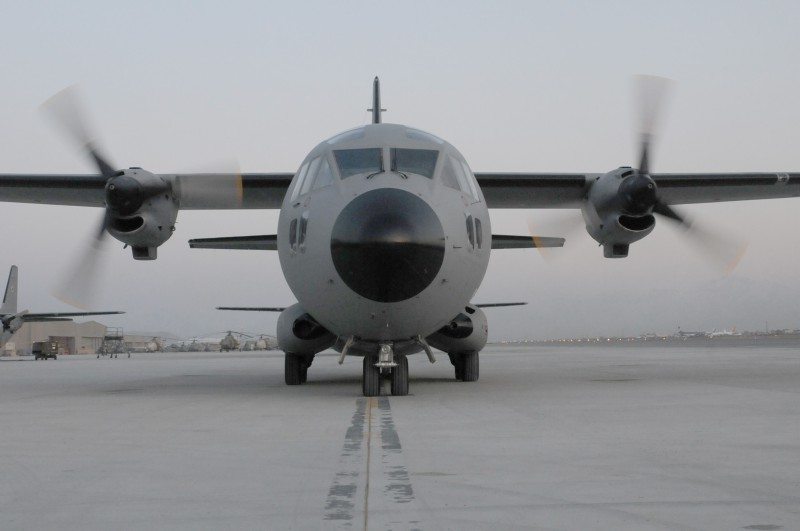With the recent collapse of the Iraqi state and its armed forces, the American taxpayer might correctly question how effective U.S. security assistance to Afghanistan has been over the past decade and whether the Afghan security state might similarly falter after the bulk of U.S. and NATO forces redeploy from the country at the end of this year.
Since the beginning of the Afghan war, the United States has provided around $56 billion to train and equip the Afghan Security Forces, including its nascent Air Force. A quick look at just one procurement program, the G222, also referred to as the C-27A Spartan, shows just how wasteful and dubious American efforts at equipping the Afghan Air Force have been to date. After spending hundreds of millions of dollars on this aircraft program, it was cancelled due to Pentagon mismanagement.
The Afghan Air Force currently relies on a fleet of over one hundred Russian- and American-manufactured helicopters and fixed-wing aircraft. The Afghans had operated Soviet-era An-32 transport aircraft as a means of providing medium airlift; however, these aging aircraft were retired in 2011.
In order to replace the An-32s, the United States awarded a contract in 2008 to Alenia North America, a subsidiary of the Italian defense contractor Finmeccanica, to purchase and refurbish eighteen used G222 transport aircraft from the Italian Air Force. This contract was amended in 2010 to include two additional aircraft as well as sustainment and logistical support. Over the course of the contract, L3 Systems Field Support, DynCorp International, and Alenia North America all provided sustainment support.
According to Federal Acquisition Regulation, both the logistical contractor and the military’s project management office (PMO) are required to outline how they will sustain an aircraft like the G222 over the entirety of its lifetime. This includes ensuring the availability of spare parts, potential problems that may impact acquisition, and cost estimates for long-term sustainment.
But according to a Department of Defense Inspector General (DoD IG) audit report, G222 PMO officials did not ensure the availability of spare parts critical to the aircraft’s operational performance. As a result, by December 2011, the entire G222 fleet had been grounded in Kabul due to a lack of spare parts and poor management.
By September 2012, of the sixteen aircraft that had been delivered to Afghanistan, nine were authorized to fly, one was awaiting flight-authorization, and the remaining six had been “cannibalized” in order to secure spare parts for the other nine aircraft. Still, according to the DoD IG, “although nine aircraft were authorized to fly, the number of aircraft able to fly on any given day varied from zero to three because of problems associated with maintenance and spare parts.”
That’s right, of the sixteen aircraft the United States had provided to the Afghan Security Forces, a maximum of three were available for flight operations on any given day.
Due to poor contract management and the unavailability of spare parts, between January and September 2012, the G222 fleet flew a total of 234 hours, even though the contract required a minimum of 4,500 flying hours. A spokesperson for the Afghan Air Force, Colonel Mohammad Bahadur, told Stars and Stripes that the aircraft arrived in Afghanistan without an adequate supply of spare parts, and that, “For a small part, you need to wait for weeks or months.”
After spending $486.1 million on the original twenty aircraft (of which only sixteen were delivered), including $60.5 million on spare parts, the Air Force decided not to renew the contract with Alenia for either additional aircraft or further sustainment of the current G222 fleet. DoD IG estimated that the Air Force would have needed to spend an additional $200 million to secure the spare parts necessary to keep the Spartans flying.
Remarkably, the Air Force attempted to place the blame squarely on the contractor, Alenia. According to a statement provided to The Wall Street Journal, the Air Force claimed that, “This decision [not to renew the G222 contract] comes after failed attempts by the contractor to generate a sufficient number of fully mission-capable aircraft that would provide an effective airlift capability for the AAF.” However, federal acquisition regulations require procurement officials to adequately manage and plan for spare parts inventory and proper long-term sustainment.
Ultimately, the DoD IG laid the blame on NATO and PMO officials, pointing out that they had failed to “effectively manage” the program and may have wasted hundreds of millions of dollars on an aircraft that was cost-prohibitive and for which critical spare parts were unavailable.
Moreover, military officials determined that the aircraft did not meet operational requirements in the first place. According to U.S. Lieutenant General Charles Davis, “Just about everything you can think of was wrong for it other than the airplane was built for the size of cargo and mission they needed….Other than that, it didn’t really meet any of the requirements.”
The Special Inspector General for Afghanistan Reconstruction (SIGAR), John Sopko, also is in the process of investigating the G222 debacle. Last year, he told NBC News that, “We are just starting to gather the facts, so I cannot tell you whether it was criminal fraud or just plain mismanagement….But what I can say for sure, it is that this wastefulness is not an isolated incident in Afghanistan.”
Currently, SIGAR has around two hundred auditors who are attempting to figure out where exactly the $100 billion that the United States has provided in aid to Afghanistan has gone. What percentage of that aid went to its intended target and how much was wasted remains to be seen.










